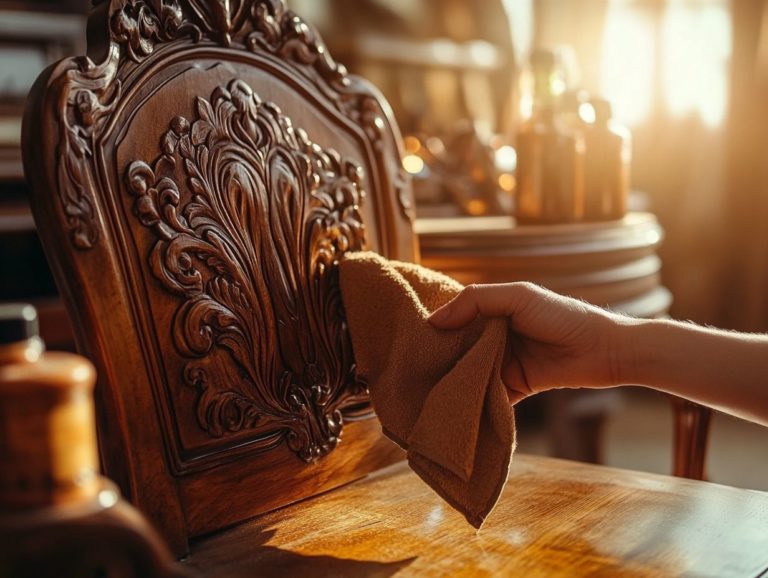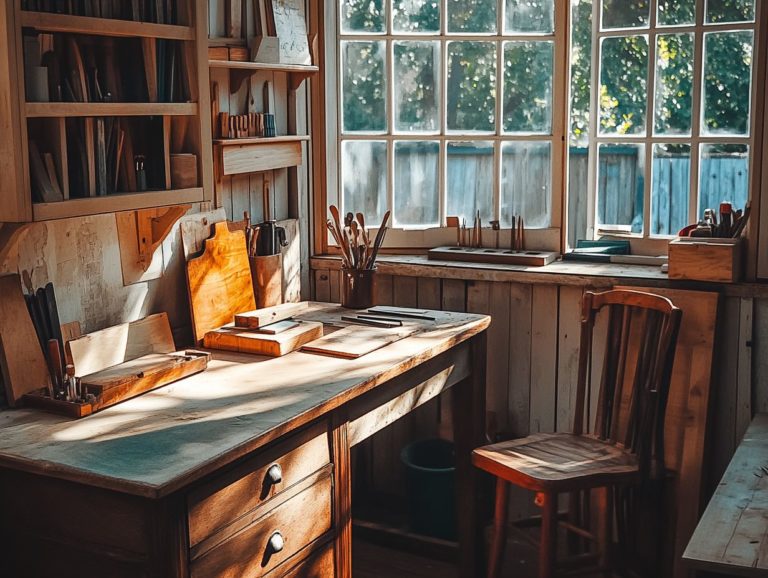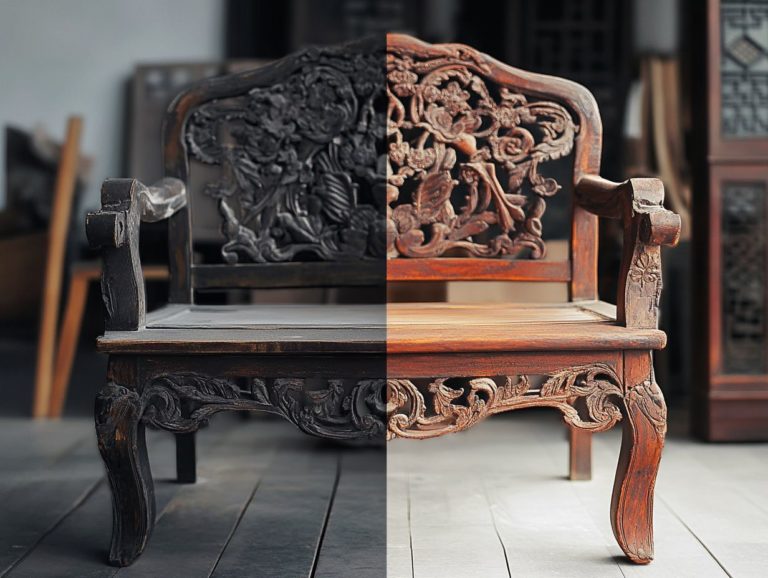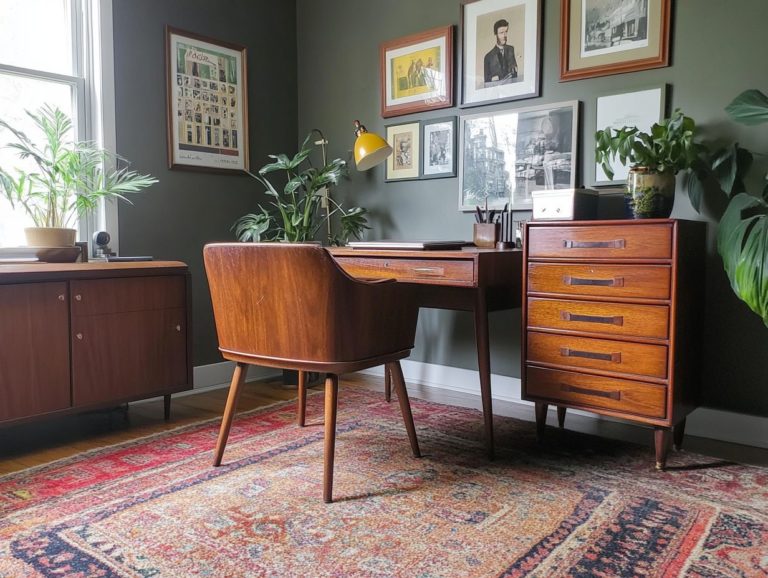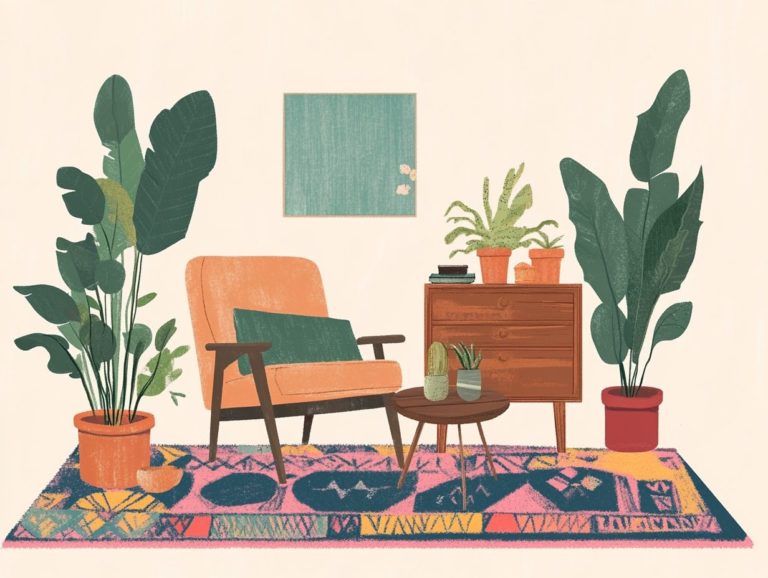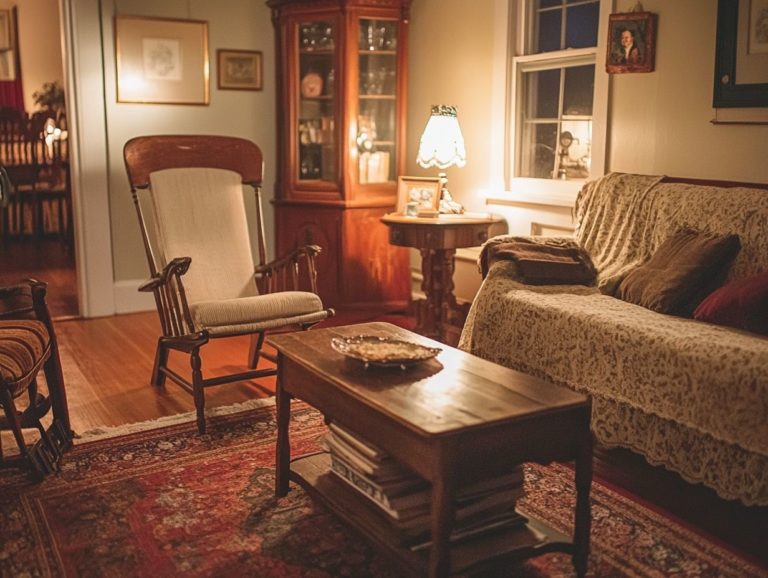Upcycling Vintage Chairs: A Creative Project
Upcycling vintage chairs isn t merely a passing trend; it s your chance to revitalize overlooked treasures while contributing positively to the environment.
Explore the many benefits of upcycling, from minimizing waste to infusing your living space with a unique, personal flair. Discover how to choose the ideal chair, gather the necessary materials, and follow a comprehensive step-by-step guide for a stunning transformation.
Find practical tips to make your project shine. Get ready to unleash your creativity!
Contents
Key Takeaways:
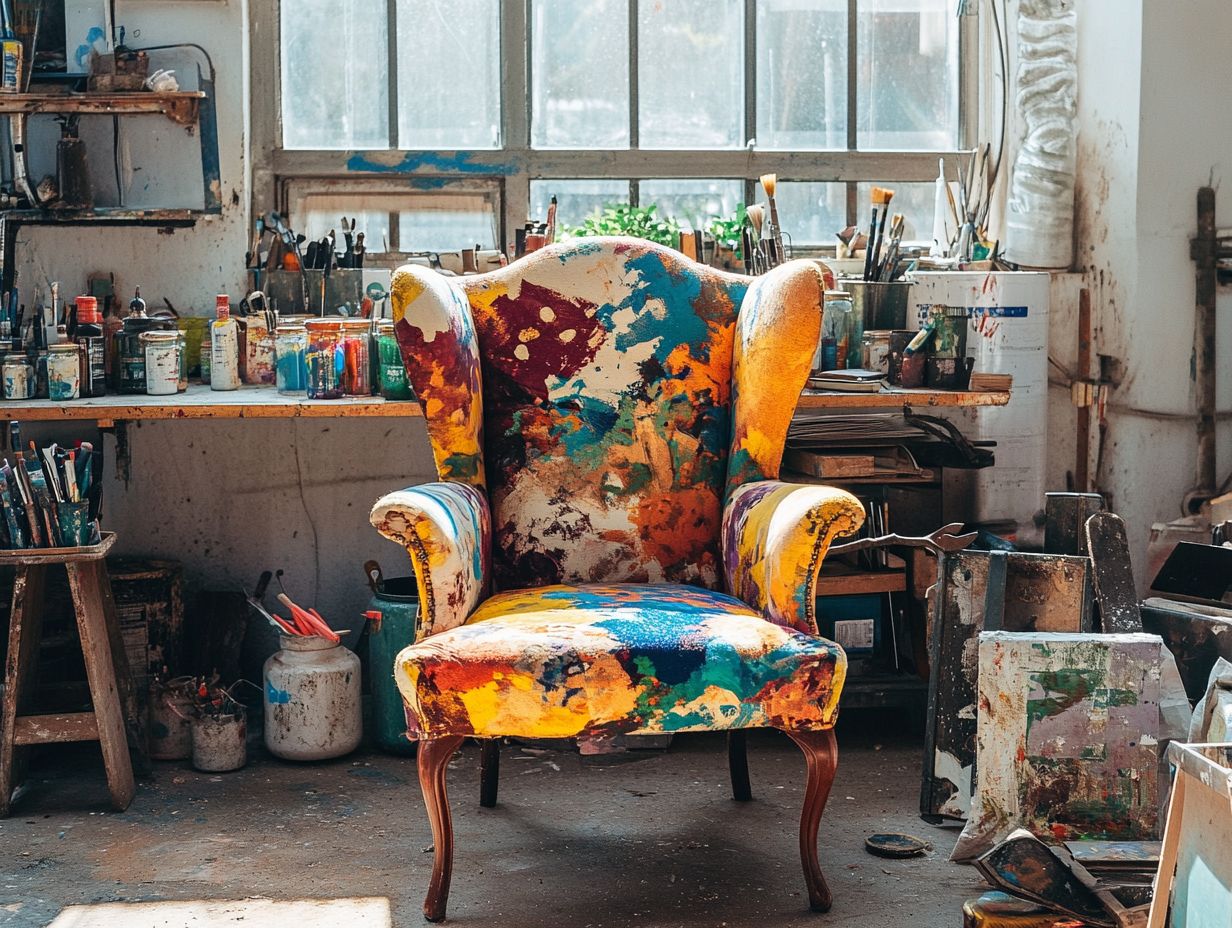
- Transform old vintage chairs into unique pieces.
- Upcycling benefits the environment and enhances home decor.
- Consider material, design, and condition when choosing a chair.
- Gather supplies and follow a clear guide for success.
- Boost creativity with tips on preparation and finishing.
What is Upcycling?
Upcycling is your opportunity to transform old or discarded materials into new products that boast enhanced value and function. This practice reduces waste and supports sustainability in design and home decor. By repurposing items like vintage chairs, you can breathe new life into furniture that might otherwise find its way to a landfill.
Upcycling invites you to unleash your creativity and imagination, turning those old chairs into unique pieces that reflect your personal style while making a positive impact on the environment.
For instance, imagine refinishing a vintage wooden chair with bold paint colors or stylish upholstery, transforming it into a stunning statement piece for any room. You might also consider using old chairs to create multifunctional storage solutions or charming garden planters, showcasing the incredible versatility of upcycling vintage furniture.
This practice transcends mere aesthetics; it plays a crucial role in sustainability by minimizing your environmental footprint.
Engaging in upcycling projects often fosters a vibrant sense of community, where you can share ideas and skills that celebrate creativity while promoting an eco-friendly lifestyle.
Benefits of Upcycling Vintage Chairs
Upcycling vintage chairs offers a wealth of advantages, both for the environment and your personal space, making it a highly enticing choice for DIY enthusiasts and eco-conscious individuals. By reimagining those old chairs into functional and visually stunning d cor, you not only play a role in minimizing waste but also craft a distinctive style that reflects your personality in your home.
Environmental and Personal Benefits
The environmental benefits of upcycling those old chairs are truly remarkable. By doing so, you re not just reducing waste; you re conserving resources and minimizing the carbon footprint that comes with manufacturing new furniture. On a personal level, upcycling grants you a creative outlet, allowing you to express your unique style while diving into a fulfilling DIY project.
When you transform discarded wooden chairs into one-of-a-kind pieces, you re not only preventing unnecessary landfill accumulation but also saving materials that would otherwise contribute to deforestation. This practice encourages you to develop new skills, from sanding to painting and reupholstering, enhancing both your craftsmanship and confidence.
The satisfaction that comes from breathing new life into a piece of furniture is unrivaled, fostering a profound sense of accomplishment. Just imagine taking an old chair and turning it into a vibrant garden seat or a stylish accent for your living room. Projects like these not only beautify your home but also deepen your personal connection to the environment and its preservation.
Choosing the Right Chair for Upcycling
Choosing the perfect chair for upcycling is essential for a successful transformation. You ll often discover hidden gems at thrift stores, flea markets, or garage sales that can serve as the ideal foundation for your project.
A vintage chair or a classic wooden piece offers an excellent canvas for innovative DIY endeavors, providing ample opportunity for your creativity and personal expression to shine.
Join the upcycling movement and start your project today!
Factors to Consider
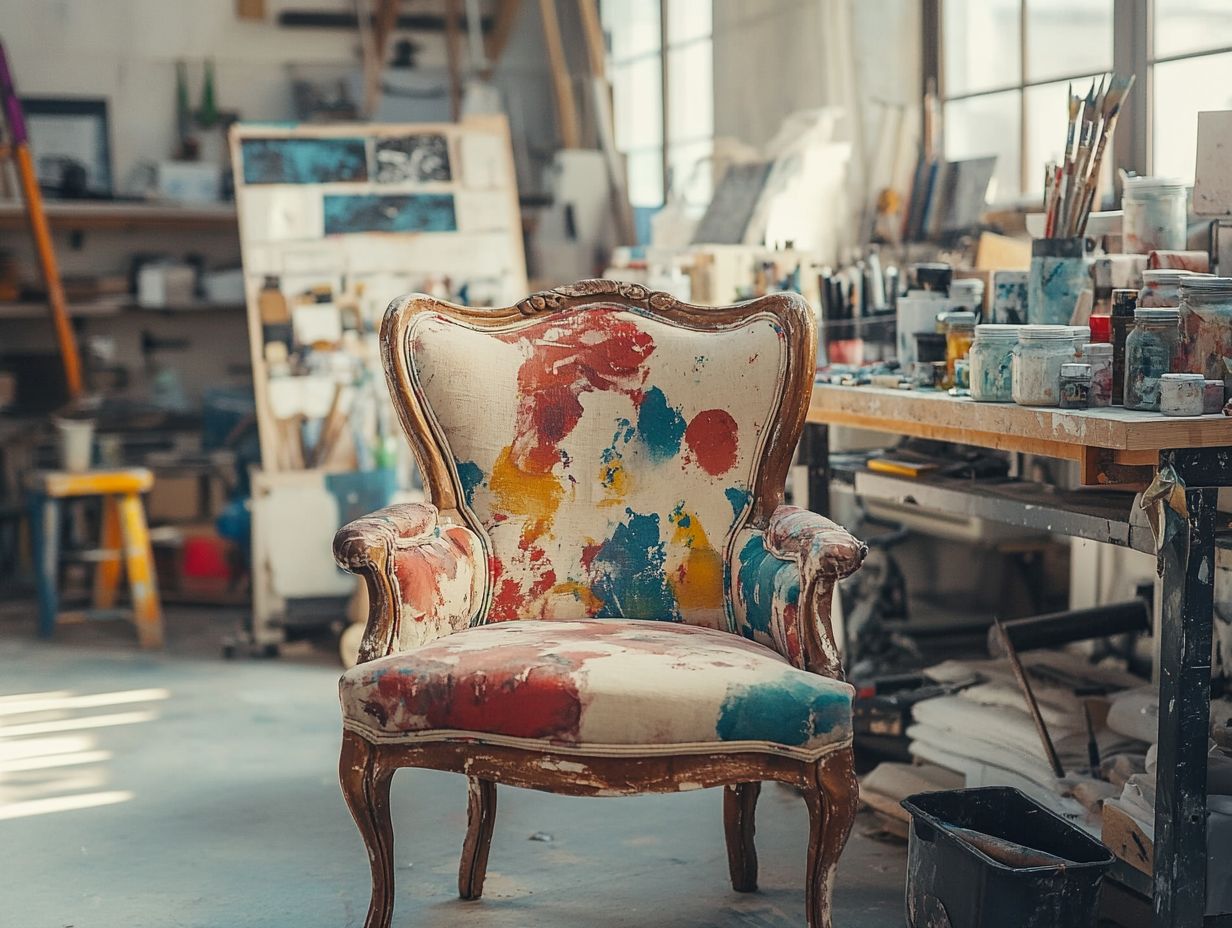
When you re hunting for an old chair to upcycle, keep several key factors in mind: the chair’s condition, materials, style, and its potential for a new purpose. A sturdy vintage chair can serve as the perfect base for a creative project, whether it s a charming storage bench or a delightful garden planter.
-
First, assess its condition. A chair with minor scratches or tears can often be rejuvenated with a fresh coat of paint or new upholstery. However, a broken frame may need more intricate repairs that require extra effort.
-
Materials are also crucial in your decision-making. Sturdy hardwood chairs are fantastic for heavy-duty transformations, while lighter materials might inspire delicate designs, like a whimsical swing.
-
Don t overlook style; the chair s aesthetic can guide your transformation process, allowing you to create either an eclectic or cohesive look that complements your decor.
To evaluate a chair s potential, think about its shape, size, and functionality. Could it be reimagined as a unique side table or a quirky bookshelf? Visualizing the final piece can spark your creativity and set the stage for a successful upcycling adventure.
Materials and Tools Needed
To successfully upcycle vintage chairs, equip yourself with the right materials and tools. This ensures a seamless and rewarding transformation.
Gather key supplies like diverse paint techniques and disassembly tools. Consider investing in premium paint brands like Annie Sloan or Dixie Belle. They can elevate your DIY project with a polished, professional finish.
Essential Supplies for the Project
Essential supplies include:
- Sanders
- Brushes
- Paints
- Chalk paint
- Bondo (a type of filler for repairs)
Investing in quality tools can make a huge difference! Specialty brushes create unique textures when applying paint, and a high-quality primer enhances adhesion and makes colors pop.
For furniture repair, wood glue and clamps are essential for securing loose joints. Wood filler works wonders for mending imperfections.
A heat gun or stripping tool may be necessary to remove old finishes, preparing the surface for a fresh coat. Your choice of materials and tools can ignite your creativity and lead to remarkable results in any upcycling endeavor.
Step-by-Step Guide to Upcycling Vintage Chairs
A step-by-step guide to upcycling vintage chairs helps you, the DIY enthusiast, craft stunning transformations that elevate both functionality and aesthetics of your furniture.
By carefully preparing the chair, choosing the ideal painting techniques, and exploring inventive ideas, you ll be amazed at how easily you can turn an ordinary piece into an extraordinary masterpiece!
Preparation and Painting
Preparation is vital for upcycling your vintage chair. It ensures your piece is clean, sanded, and ready for painting.
This step opens up various techniques. You can use distressing or layering colors to add depth.
A well-prepared surface will elevate your DIY project. It allows the beauty of your transformed chair to shine.
To kick things off, remove old paint or varnish with paint remover or sanding paper. Pay attention to the chair s intricate details.
Once you ve stripped it down, wipe the surface with a damp cloth to rid it of dust and debris. Give it plenty of time to dry completely.
After cleaning, gently sand the chair using medium-grit sandpaper, focusing on any imperfections. This not only smooths the surface but also prepares it for better paint adhesion.
Now, unleash your creativity with various painting techniques. You can use a sponge for a textured finish or a brush for precise applications, ensuring each layer enhances the chair’s vintage allure. For more inspiration, check out upcycling vintage finds: creative DIY ideas.
Reupholstering and Finishing
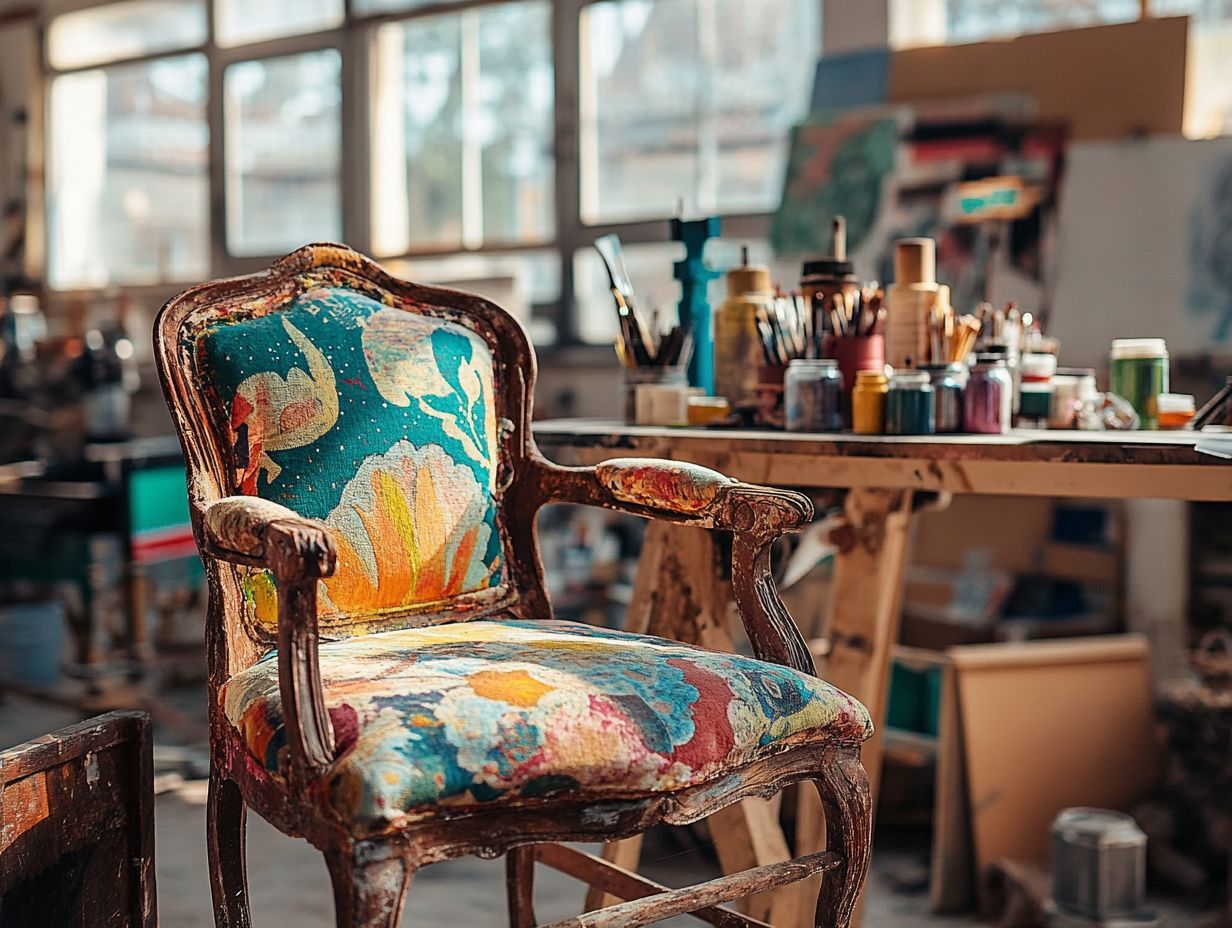
Reupholstering and finishing a vintage chair can truly elevate its transformation. It infuses it with a fresh and vibrant touch that reflects your unique style and creativity.
This stage often requires you to select new fabrics. Ensure that every finishing detail aligns perfectly with the overall vision of your DIY project.
Choosing the right fabric is essential. You need to balance durability with aesthetic appeal. Popular options include upholstery-grade cottons, linens, or even leather each offering unique textures and colors to showcase your personal flair.
The reupholstering journey begins with removing old fabric and padding. This paves the way for you to reconstruct the chair with high-quality materials that promise extra comfort and longevity.
You might find yourself employing techniques such as stapling, tacking, or sewing to secure the new upholstery in place.
Never underestimate the impact of attention to detail in those finishing touches. Adding decorative trims, buttons, or a fresh coat of paint can significantly enhance the chair’s overall aesthetic appeal, ultimately breathing new life into a once-outdated piece.
Tips and Tricks for a Successful Upcycling Project
By incorporating thoughtful tips and tricks into your upcycling project, you can enhance your experience and achieve a truly stunning final product.
This approach allows your creativity to flourish while effectively minimizing mistakes.
From carefully planning your design to choosing the perfect materials, these insights can elevate the entire process into a gratifying endeavor.
Maximizing Creativity and Minimizing Mistakes
Maximizing your creativity while minimizing mistakes in your upcycling project can lead to a furniture makeover that is both unique and deeply satisfying.
By planning ahead and exploring various upcycle ideas, you can sidestep common pitfalls, ensuring your project remains enjoyable and successful.
This approach enhances the aesthetic value of your space while promoting sustainability and individual expression.
One effective strategy is to select projects that resonate with your personal interests. For instance, transforming old wooden pallets into rustic coffee tables or repurposing vintage suitcases into stylish storage solutions has become a favorite among DIY enthusiasts.
To set yourself up for success, consider these best practices:
- Sketch out your designs beforehand
- Gather the right tools
- Start with simple projects if you re new to upcycling
By following these guidelines, you can expect to boost your creativity and produce pieces that are truly one-of-a-kind.
Frequently Asked Questions
Curious about upcycling? Here are some common questions answered!
What is upcycling?
Upcycling is the process of transforming old or discarded items into something new and useful, often with added value or functionality.
Now that you’re equipped with these tips, it’s time to dive into your upcycling adventure!
Why should I consider upcycling vintage chairs?
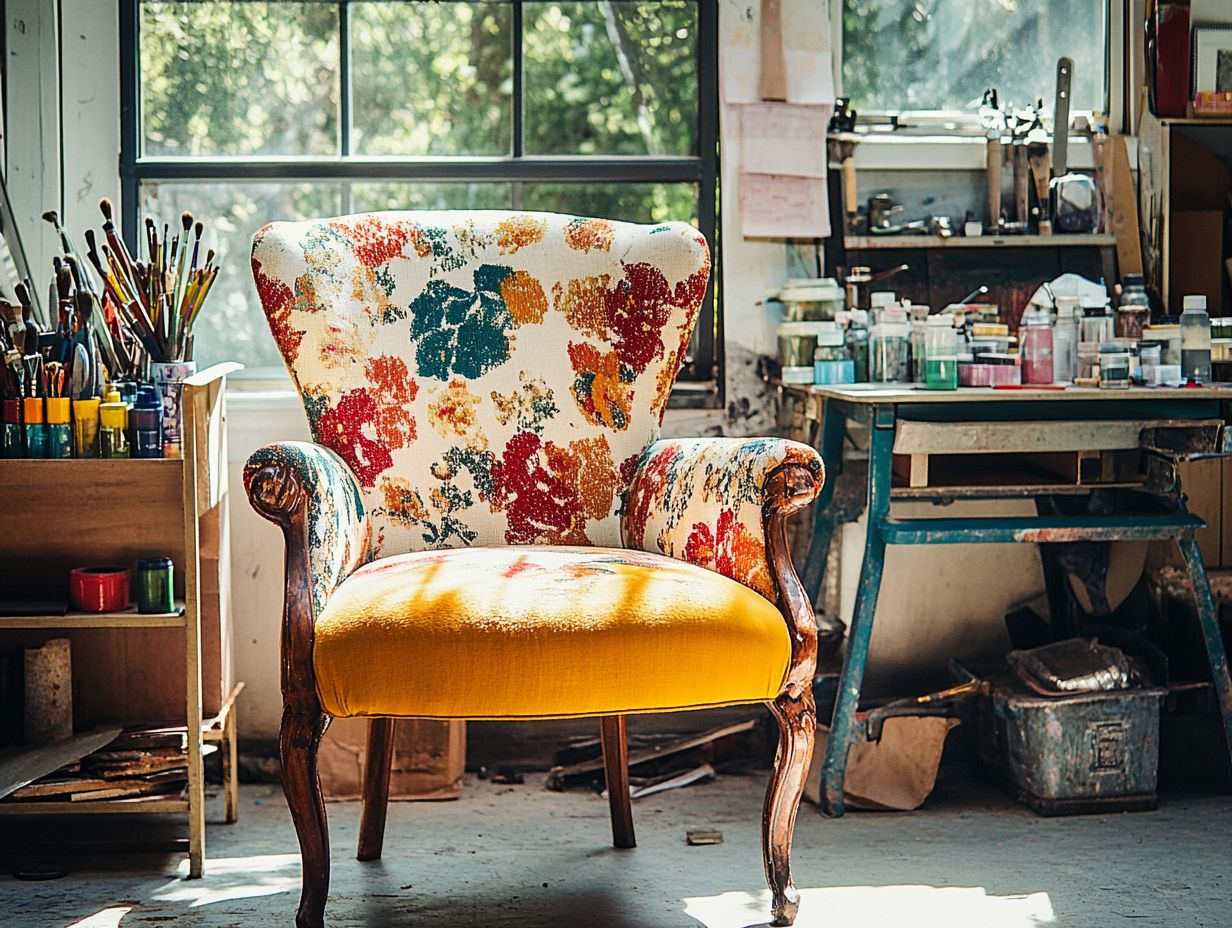
Upcycling means transforming old items into something new and useful. It s a fantastic way to reduce waste and breathe new life into worn-out furniture.
You can create unique and personalized pieces for your home!
Do I need any special skills or tools to upcycle vintage chairs?
No, upcycling vintage chairs is a simple and fun project for everyone. You only need basic tools like sandpaper, paint, and a screwdriver to get started.
What are some creative ideas for upcycling vintage chairs?
The possibilities for upcycling vintage chairs are endless! Consider repainting them, adding new upholstery, or even transforming them into one-of-a-kind shelves or plant stands.
Where can I find affordable vintage chairs to upcycle?
Discover hidden gems at thrift stores and flea markets! Your perfect vintage chair is waiting for you in online marketplaces like eBay or Facebook Marketplace.
Don’t forget to ask friends and family if they have any old chairs they no longer need!
Is upcycling vintage chairs environmentally friendly?
Absolutely! Upcycling vintage chairs helps reduce waste and promotes sustainable practices.
It also eliminates the need for new furniture production, which can harm the environment.

